Silambam Examines Eastern and European Traditions Through Connection
On June 7, 2024 at the Miller Outdoor Theatre, Silambam Houston presented a curious and intriguing theatrical thesis in mining the commonalities of South Indian and Baroque dance and music. I was eager to see Artistic Director Lavanya Rajagopalan’s vision come to life in The Baroque-Carnatic Connection, as both worlds live as disparate entities in my mind. Rajagopalan’s effort, buoyed by lead creatives from the New York Baroque Dance Company, Roopa Arts Cultural Center, and Apollo Chamber Players, proved to be a grand, if uneven, production.
The true gems of Silambam’s latest work lay in the marriage of the two genres it explores. I can’t stop thinking about the “Marubaari” section, in which the Baroque dancers are choreographed to Carnatic composers in the Bharatnatyam style. In the classical Indian dance tradition of facial expressions, dramatic poses, and detailed gestures, the Baroque ensemble appears onstage in seventeenth-century European dress.
Earlier in the program, they demonstrated their period dance replete with the era’s fancy footwork, erect posture, and romantic musicality. It was a pretty picture, a filigree of choreography, and performed with much joy. As beautiful as the dancing was, it was also still an artifact, a look into a world that no longer exists. But in “Marubaari,” the Baroque ensemble truly came alive. Each dancer moved through a series of statuesque shapes and wonderful gestures, their bodies filled with palpable emotion and real character. By placing these dancers in the context of South Indian music, the piece showed that the expressive possibilities of Carnatic compositions go beyond its immediate culture.
The live music, especially the South Indian selections spearheaded by Abhishek Balakrishnan and Jahnavi Murali, was stunning, and the Baroque sections were expertly led by Matthew Detrick of the Apollo Chamber Players. The confluence of dance and music was most profound in “Thillana” and “Forlane,” in which the steps of both ensembles seemed to be embedded in the accompaniment. The ensembles here are mostly separated by their own music traditions, but the transitions saw both Bharatanatyam and Baroque dancers engaging with one another through clear and smart formations.
Lavanya’s strength as a choreographer is her ability to embellish the inherent drama of her art form. This is done through interesting compositions, and in this case making maximum use of the number five. Within a single dance, there are times when a quartet is set against a solo, or a duet is staged next to a trio before settling into unison again. The constantly changing permutations suggest the tempestuousness of human conflict.
In this way, the everyday life that is expressed through the classical Indian dance feels a bit more dramatic than the stately, courtly passes of the European form. It’s important to note that when the Bharatanatyam ensemble was paired with Western accompaniment, the form’s signature syncopation was a bit lost, and the gestures lost a bit of their intensity.
The finale features more of the integration between the ensembles, and this is an especially memorable moment seeing two dance styles performed beautifully side-by-side. The juxtaposition of costumes is striking but in a complementary way. It was a bit strange, though, that the finale included a rendition of “God Saves the Queen” considering Britain’s centuries long domination of the Indian subcontinent, but perhaps this was an act of postcolonial subversion? But the dancing was lovely, with the choreographers having chosen steps and sequences that looked like they could have been from the same family.
What I took away from The Baroque-Carnatic Connection was an understanding of how time and place and personal history can shape one’s perception of the various performance genres on display. I’ve always loved all of the classical Indian dances, and I appreciated the window into the Baroque era through its court dances. I was in awe of the Carnatic music with its deep richness and warm quality. I think it has stood the test of time because of its spiritual origins in the ancient Hindu texts.
I reacted to the Baroque music differently. As a student cellist, I remember getting a CD of Vivaldi’s Four Seasons and listening to it nonstop. But in a time of deep unrest at almost all levels of human society, the decadence of his music and that of his contemporaries seems overly indulgent. The compositions flirt with the ostentatious, the notes exaggerated and frilly. Whereas I felt connected to the Carnatic music, I struggled to find personal inspiration in the Baroque. I found interest in it when it was paired with the Bharatanatyam dancing, the elegance of those votive shapes seemingly timeless.
I think that is why productions like this are so important, to be able to see what cultural traditions still retain their potency and to figure out where that power comes from. Beauty abounds in human creativity, across time, space, and continents.

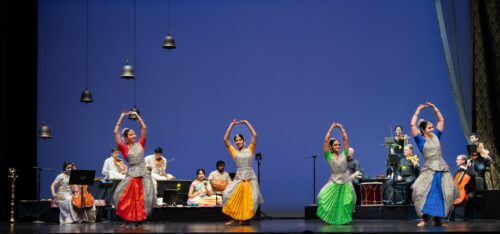
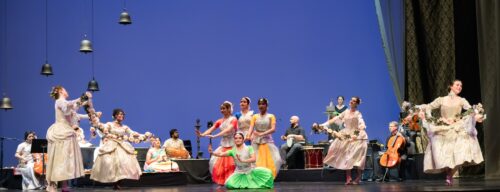
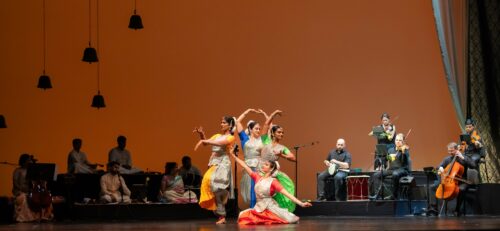
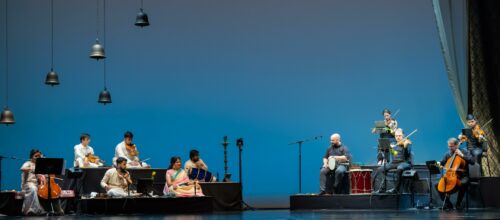
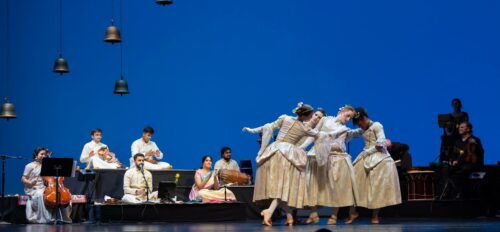


Thank you so much, Adam, for this very thoughtful review!
Because I’ve had this comment from others, I’ll clarify – there is a 19th century Indian composition by Muthuswamy Dikshitar set in the exact same tune as God Save The Queen. It is also the tune of America The Beautiful. It makes for an interesting melange of ideas, given the setting of a production of European and Indian music and dance on a stage in America 🙂